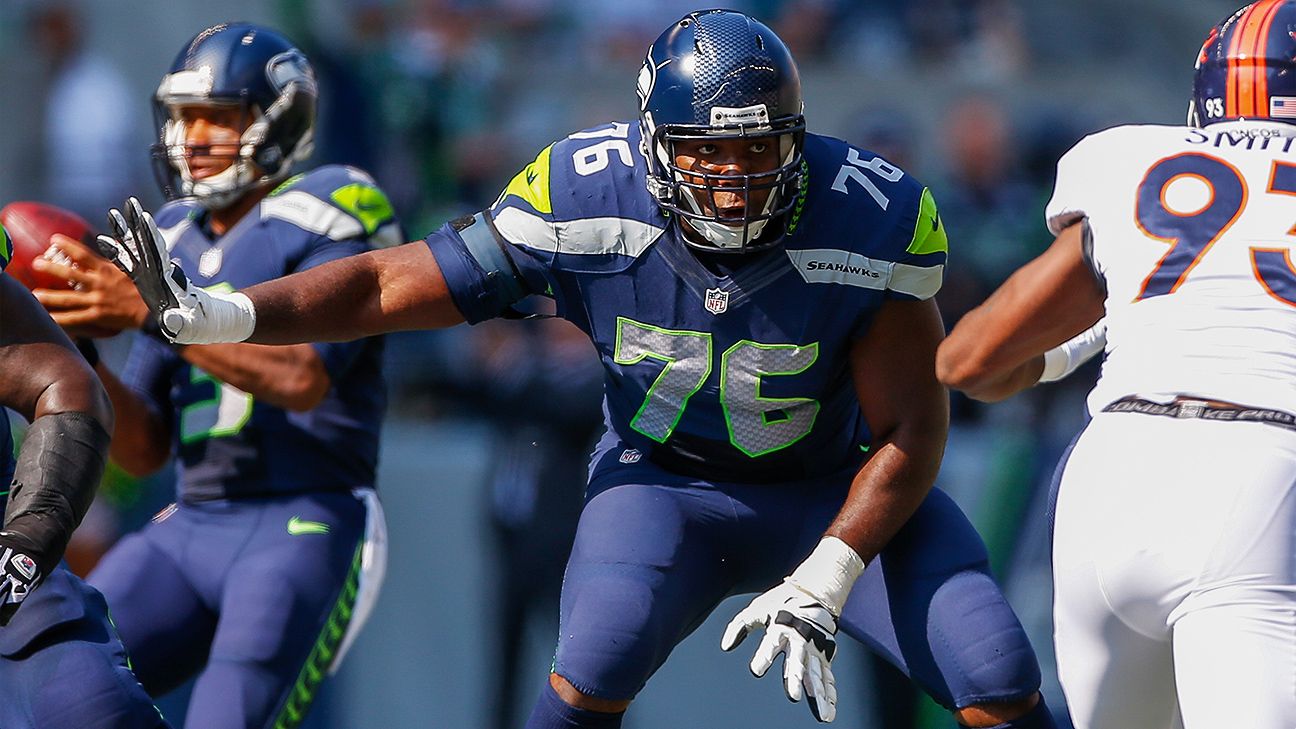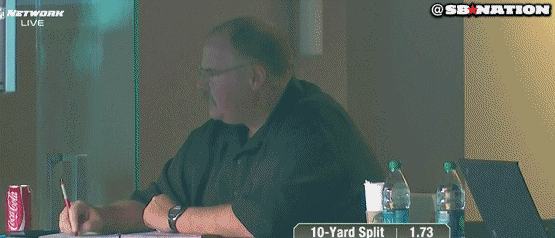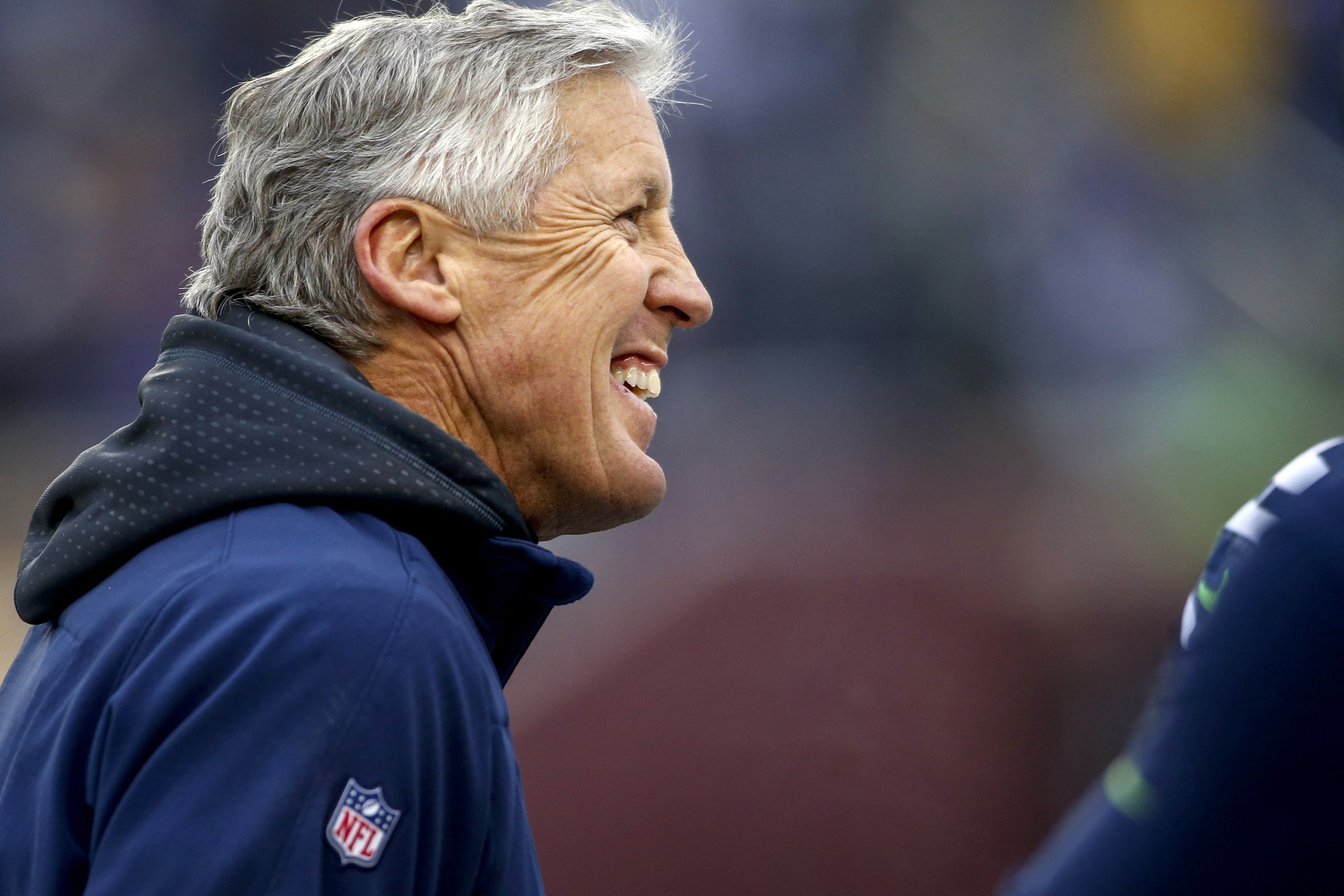
If the Seahawks need to replace Bruce Irvin it could be with a very different player
#1 Cleveland Browns — Joey Bosa (DE, Ohio State)
There’s no can’t-miss prospect at #1, certainly not at quarterback. It’s impossible to project what the Browns do here. Do they simply take a new QB? Or does a perennially bad franchise just go for the best player?
#2 Tennessee Titans — Jaylon Smith (LB, Notre Dame)
The Titans have a quality left tackle and they’re fifth in the NFL for sacks (34). Smith is just an incredible, athletic modern-day linebacker. He’ll fit into any scheme. Playmaker.
#3 San Diego Chargers — Laremy Tunsil (T, Ole Miss)
The Chargers badly need to repair their offensive line. Tunsil performed well against Texas A&M’s Myles Garrett and is ready to turn pro. His kick-slide, power in the run game and willingness to get to the second level make him an intriguing prospect.
#4 Jacksonville Jaguars — Robert Nkemdiche (DE, Ole Miss)
The Jaguars have a decent collection of talent — now it’s just a case of bringing it all together. Nkemdiche could end up being a Michael Bennett for this defense — lining up at end before kicking inside in NASCAR packages.
#5 Baltimore Ravens — Tre’Davious White (CB, LSU)
White has it all — coverage skills, smooth hips, athleticism. He’s a good kick-returner. He was awarded the coveted #18 jersey at LSU for this season. Teams are going to love his tape and character. He will go early.
#6 New Orleans Saints — Paxton Lynch (QB, Memphis)
If Sean Payton departs at the end of the season — will Drew Brees follow? They are on the verge of a major rebuild. Brees’ cap hit in 2016 is a staggering $30m — they can save $20m by cutting him. A new coach might start with his own guy at QB.
#7 Dallas Cowboys — Jaylen Ramsey (CB/S, Florida State)
Ramsey has some nice tape to go along with some iffy stuff too. He’s shown he can play corner and safety. The combine will help teams analyse his best position at the next level. He could be a rangy free safety.
#8 Detroit Lions — Shon Coleman (T, Auburn)
For me he’s the best tackle in the SEC and the most underrated player in the country. Cancer survivor. He can kick-slide, dominate in the power-run game, explode into a linebacker at the second level. He has a mean-streak. Love him.
#9 San Francisco 49ers — Taylor Decker (T, Ohio State)
Will Joe Staley move on? Will Alex Boone move on? The 49ers O-line is bad enough as it is without losing their two most experienced bodies. Decker could be a good replacement for Staley at left tackle.
#10 St. Louis Rams — Laquon Treadwell (WR, Ole Miss)
The Rams have turned into a mess and who knows what happens next. Do they draft a quarterback here? It’s perhaps more in Jeff Fisher’s nature to find a veteran who can hold things together (Drew Brees?) and give them a weapon.
#11 Miami Dolphins — Eli Apple (CB, Ohio State)
The Dolphins are weak at cornerback and this could be a sweet-spot at the position. Apple has good size, keeps plays in front of him and limits the damage. Occasionally he’ll make a very sharp break on the football. Has the potential to be great.
#12 New York Giants — DeForest Buckner (DE, Oregon)
It’s not often discussed because Oregon has had a relative down year but Buckner has 9.5 sacks in 2015. He’s a better player than Arik Armstead (#17 overall pick this year). The Giants need something — anything — on defense.
#13 Oakland Raiders — Cameron Sutton (CB, Tennessee)
Another team struggling at corner. D.J. Hayden hasn’t worked out and their best defensive back has just turned 39. Sutton is a fantastic athlete and just looks the part. Expect a big jump after the combine.
#14 Philadelphia Eagles — Jack Conklin (T, Michigan State)
It’s hard to know what the Eagles are going to do. Are they the most unpredictable team in the league? One week imploding, the next exploding in New England. Is Chip Kelly staying or going? Conklin could move inside to guard.
#15 Chicago Bears — Darron Lee (LB, Ohio State)
Lee’s underrated. Simple as that. He’s always around the ball. He’s not the same athlete as Ryan Shazier but they have a similar style. This is the range where Shazier was drafted.
#16 Tampa Bay Buccaneers — Corey Coleman (WR, Baylor)
They have bigger needs but just imagine Jameis Winston throwing to Mike Evans and Corey Coleman. You can build a franchise around that. Vincent Jackson is coming to the end of his distinguished career.
#17 Atlanta Falcons — Myles Jack (LB, UCLA)
He suffered a knee injury during the season and it could impact his ability to flash pre-draft. Jack has good range and could play inside or outside linebacker in the Falcons’ defensive scheme.
#18 Buffalo Bills — Andrew Billings (DT, Baylor)
I’ve warmed up to Billings. He’s probably the best penetrating DT in this class. He can cause some havoc at times. He’s not at the same level as Sheldon Richardson or Aaron Donald, however.
#19 Houston Texans — Jared Goff (QB, California)
A no-brainer pick really. They need an answer at quarterback. They can’t keep drifting along. Goff has some inspired play on tape — he can be a surgeon. He needs to be less erratic and more controlled. Bill O’Brien needs ‘his guy’. Don’t sleep on Carson Wentz.
#20 Pittsburgh Steelers — Germain Ifedi (T, Texas A&M)
A powerful, athletic looking tackle who moves well. There’s a ton of potential here. He played very well against Ole Miss. The Steelers have shown over the last few years they’re willing to go O-line early and wait on cornerbacks.
#21 Washington — Michael Thomas (WR, Ohio State)
If Pierre Garcon moves on they’re a bit limited at receiver. They still have a ton of needs. Thomas is big and fast — and he’s very good at getting open. He could be a #1 at the next level. Kirk Cousins is the type of QB who needs help.
#22 Indianapolis Colts — Mackensie Alexander (CB, Clemson)
Vontae Davis is solid — but the defense still needs work overall. Adding a cornerback partner would be a good start. What can the Colts hang their hat on when it comes to the defense?
#23 New York Jets — Tim Williams (DE, Alabama)
He’s having a great year and I didn’t realise until this week he is draft eligible. He has 9.5 sacks for the season and is a classic 3-4 outside rusher. The Jets defense could use some extra speed off the edge.
#24 Kansas City — Will Fuller (WR, Notre Dame)
He said he would return to Notre Dame and then asked to hear from the draft committee. It makes sense for Fuller to turn pro — he’s ready. Such a fun player to watch. Incredibly dynamic. Why not add a wing-man for Jeremy Maclin?
#25 Seattle Seahawks — Miles Killebrew (S/LB, Souther Utah)
See below for thoughts on this pick.
#26 Minnesota Vikings — De’Runnya Wilson (WR, Mississippi State)
They are kind of tied to Teddy Bridgewater — a limited quarterback. Stefon Diggs is a nice speed option but they don’t have an outside safety-net. Wilson is similar to Kelvin Benjamin.
#27 Green Bay Packers — Adolphus Washington (DT, Ohio State)
There are times where he looks unstoppable — and times where you barely notice he’s on the field. Washington’s best fit at the next level could be D-end in a 3-4 scheme. He’s a versatile player who can line up in different defensive fronts.
#28 Arizona Cardinals — Ezekiel Elliott (RB, Ohio State)
It’d almost be unfair if a team as complete and ready as the Cardinals had a weapon like Elliott fall into their laps. I’m not convinced he’ll go early in round one. That’s good for him. He can go to a contender and have an instant impact.
#29 Cincinnati Bengals — Desmond King (CB, Iowa)
Pacman Jones can’t go on forever. King is a feisty cornerback with a powerful lower-body and the ability to shed a block and contribute in the run-game. He’s a ball-hawk too with eight interceptions in 2015.
#30 Denver Broncos — Ronnie Stanley (T, Notre Dame)
After failing to land Joe Thomas, tackle could be a target for the Broncos in round one. I’m not a fan of Ronnie Stanley — he looks stiff, he offers nothing at the second level and that Shaq Lawson de-pantsing is difficult to shake off.
#31 Carolina Panthers — Tyler Boyd (WR, Pittsburgh)
Boyd is just a really good receiver. Great skills as a route runner. Pittsburgh’s best playmaker by far. Look at the way he gave Iowa fits this year. He can be a nice compliment to Kelvin Benjamin and Greg Olsen.
So what about the Seahawks?
I wanted to get Miles Killebrew on the podcast this week with this mock draft in mind. I wanted people to see where I’m coming from considering the projection has a defensive back from Southern Utah in the first round.
When you listen to Killebrew speak — it’s clear he has an infectious passion for the game. And that shows up on tape. Combine that with his size (6-2, 230lbs) and 4.4 speed — and you’re looking at a very intriguing prospect.
He’s been invited to the Senior Bowl where I expect he’ll impress. The combine will be big. I will make the case for why the Seahawks might draft him early — and why he might go as early as day one.
The Seahawks had a fifth-year option on Bruce Irvin’s contract that would’ve paid him $7.8m in 2016. I thought they were going to take it. Irvin became quite the playmaker in 2014 and $7.8m isn’t exactly a hideous amount for a player that has provided sacks and picks over the last 12 months.
Irvin could command a salary worth around $7-8m per year on the open market. By not taking up the option, that to me suggests the Seahawks are willing to let him test the market and find out exactly how much he’s worth. That obviously lends itself to the possibility he signs elsewhere. The Falcons are projected to have $15m in free cap space. Irvin is from Atlanta and Dan Quinn is coaching the Falcons. It’d make a lot of sense. There will be other suitors.
That doesn’t mean an Irvin extension is out of the question. This week Davis Hsu put together an off-season projection that included a new deal for Irvin and letting J.R. Sweezy walk:
As you can see, Irvin’s first-year cap hit is relatively low ($4.5m in 2016). I think there are a couple of things to consider though. How determined is Irvin to at least test the market, especially after the apparent ‘snub’ of not taking the fifth year option? If it comes down to a bidding war, are the Seahawks going to go big to keep their man?
I also suspect they really like Sweezy, for better or worse. It wouldn’t be a total shock if Sweezy signed a contract extension in the next week or so — similar to Cliff Avril and K.J. Wright last year.
I’m also cautious that they drafted Mark Glowinski this year and he’s ideally suited to the right guard spot. So there’s every chance he’s the heir apparent.
Draft position could be the most significant thing here. The later the Seahawks pick, the harder it’s going to be to get at the better offensive linemen in this class. If they’re picking from #25-31, they might prefer re-signing Russell Okung and Sweezy to provide some continuity on a blossoming O-line. That could mean no Irvin.
So how easy will it be to replace a guy who has a unique, almost unmatched skill set as a pass rusher who can cover, blow up screens and make the occasional game-changing turnover (and sack Cam Newton year after year)?
It’s impossible, in a word. You’ll not find another Bruce. That’s perhaps the biggest reason for re-signing him.
Do you need a carbon copy though? Or can you adapt the role?
The Arizona Cardinals have utilised Deone Bucannon — a college safety — almost exclusively at linebacker. He ran a 4.49 at his combine at 6-1 and 211lbs. The Carolina Panthers drafted Shaq Thompson — who started as a safety at Washington before switching to linebacker — and use him in a similar way.
It’s a plan that seems to be working for both clubs.
Bucannon was the #27 overall pick in 2014. Thompson went #25 overall this year.
Is it really that preposterous that the Seahawks would consider drafting a 6-2, 230lbs safety who runs in the 4.4’s to play linebacker — similar to Bucannon and Thompson?
It’d be a different skill set to Irvin — but as noted, there isn’t another Bruce out there. If you can’t keep him — and it might be out of their hands — you have to consider alternatives.
So can a defensive back from Southern Utah go in round one?
“He’s a better football player than Shaq Thompson and Deone Bucannon were when they came out.”
That’s a quote from a regional scout, via NFL.com.
If the scout is right and he’s a better football player than Bucannon and Thompson — and he has the athleticism — why can’t he go in the first frame and in a similar range (mid-to-late 20’s)?
Tony Pauline’s sources are saying he could be a day-two pick. That’s not a bad starting position going into the Senior Bowl and eventually the combine.
What’s more, he clearly has an appealing character. If you haven’t heard it yet, listen to the podcast from yesterday and be prepared to be impressed. He’s Russell Wilson-esque:
He also told us in the interview that he’s been told he might end up at linebacker.
None of us know whether the Seahawks would consider this kind of move — going from an athletic pass-rusher convert at linebacker to an extremely athletic defensive back convert. They might be more likely to plug in a prospect like Oklahoma’s Eric Striker. It’s something to consider over the next few weeks.
The wildcard in all of this is, of course, that Killebrew could end up being a ready-made replacement for Kam Chancellor in the future. Chancellor turns 28 next April and it’s not a stretch to wonder if he’ll be the type of player who continues well into his 30’s. His current contract takes him through until age 30.
Again, it’s something else to consider.
It feels like the futures of Okung and Irvin will have a big impact in the first round of the draft. This is, after all, a team without lots of needs in relation to the rest of the NFL. They’ve consistently had success developing their own guys at cornerback without the big investment. They’ve found solutions at defensive tackle in the veteran free agent market.
If Okung walks and they move Garry Gilliam to left tackle — drafting a right tackle early is probably very likely. If they re-sign Okung and Sweezy and Irvin departs — finding a replacement in round one could be the priority.
I believe in trends and how they help us project what a team will or won’t do. Seattle has so far spent two first round picks on offensive tackles (Okung, James Carpenter), one on a safety (Earl Thomas) and one on an athletic pass-rusher/linebacker (Irvin). There is some history targeting tackle and linebacker early and they like unique traits and athleticism. In contrast they’ve generally looked to draft cornerbacks on day three and defensive tackles in the round 3-5 range.
If they drafted Killebrew in the first round, they could look at the O-line in round two (Adam Bisnowaty? Joe Dahl? Jason Spriggs) and running back in round three (Paul Perkins? Alex Collins).






